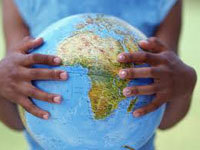Millennium Development Goals: Yes, we can!
 "There is more to do for the mother who watches her children go to bed hungry - a scandal played out a billion times each and every night. There is more to do for the young girl weighed down with wood or water when instead she should be in school. And more to do for the worker far from home in a city slum, watching jobs and remittances disappear amid global recession." (UN Secretary-General, Ban Ki-Moon)
"There is more to do for the mother who watches her children go to bed hungry - a scandal played out a billion times each and every night. There is more to do for the young girl weighed down with wood or water when instead she should be in school. And more to do for the worker far from home in a city slum, watching jobs and remittances disappear amid global recession." (UN Secretary-General, Ban Ki-Moon)
As the talks between Heads of State and Government get under way in New York for the three-day meeting of the US General Assembly on the Millennium Development Goals, the message is clear that mankind can achieve the aims of reducing poverty, combating disease, fighting hunger, protecting the environment and boosting education, although the indications of success are mixed.
Russia Today: Unilateral sanctions contrary to Millennium Development Goals - Lavrov
The Millennium Development Goals were established by the UNO in 2000 with eight basic objectives: To eradicate extreme poverty and hunger, to achieve Universal Primary Education, Gender Equality and Empowerment of Women, to reduce Child Mortality, to improve Maternal Health, to combat HIV/AIDS, Malaria and other diseases, to ensure Environmental Sustainability and finally, to develop a Global Partnership for Development.
Noble ideas. Since then, we have had two wars (Afghanistan and Iraq) costing trillions of dollars, dividing the international community and in the case of Iraq, deriding the authority or even the existence on the UNO ("a League of Nations" sneered George W. Bush) followed by a self-inflicted Global Economic Crisis, the result of the neo-liberal approach to market economics.
The Objectives and how we stand
Millennium Development Goal (MDG) 1: Eradicate extreme poverty and hunger
Although there has been some success in India and the RP China in reducing the number of people living on less than one USD/day, poverty rates have been increasing in western Asia, and little or no progress has been registered in Sub-Saharan Africa.
MDG Goal 2: Universal Primary Education
The number of children without access to primary schooling decreased from 103 million to 72 million from 1999 to 2006. However, in Sub-Saharan Africa only 71 per cent have access and 38 million children continue to be outside the school system.
MDG Goal 3: Gender Equality and Empowerment of Women
Oceania has managed to go backwards in this respect, while in Western and Central Africa, school repetition and drop-out rates among girls are common, because they are expected to provide for the family while their brothers go to school. Various factors which contribute towards low school registration rates are far more devastating among the young female population than among the young males.
MDG Goal 4: Reduction of Child Mortality
Statistics show that a child born in a "developed" country is 13 times more likely to survive than one born on "the wrong side" of a frontier. 27 countries made no progress at all between 1990 and 2006 in terms of child mortality. Low education rates among mothers and children born in rural areas and into impoverished families are naturally most at risk.
MDG Goal 5: Improvement of Maternal Health
500,000 women died during pregnancy, childbirth or in the 6 weeks after delivery in 2005. Ninety-nine per cent of these were in the developing countries. Gender equality therefore does not exist as a birthright - one in 7,300 women dies from preventable causes related to childbirth in "developed" countries, whereas in the Less Developed Countries (LDCs) the ratio is a mere 1:22.
MDG Goal 6: Combating HIV/AIDS, Malaria and other Diseases
Every 15 seconds, a person dies from AIDS. 4 people per minute, 229 per hour, 5,500 per day, while a further 7,500 become infected with HIV/AIDS daily - 2.7 million people in 2007, while in the same year 2 million people died from the disease. Meanwhile the number of patients living with HIV increased from 29.5 million in 2001 to 33 million in 2007. The epicentre: Sub-Saharan Africa.
MDG Goal 7: Ensuring Environmental Sustainability
2005 saw 28 billion metric tonnes of CO2 emissions, which registered an upturn from 1990 to 2005 of 30%. In the "developed" nations, emissions are 12 metric tonnes/person/year - as against 3 metric tonnes in LDCs. Annual growth of CO2 emission from 2000 to 2005 was higher than from 1990 to 1999. Copenhagen saw quite how far the world is from any sort of agreement.
MDG Goal 8: Development of a Global Partnership for Development
Official Development Assistance (ODA) has dropped in recent years, while many areas of Sub-Saharan Africa continue to register zero growth rates in term of improvement of quality of life.
Hope for the future
In the preliminary meetings in New York on September 20, the general message was one of optimism, concentrating on the great deal that has been achieved, while the international community was requested to remain focused to keep the goals on track. In the words of UN Secretary-General Ban Ki-Moon:
"There is more to do for the mother who watches her children go to bed hungry - a scandal played out a billion times each and every night. There is more to do for the young girl weighed down with wood or water when instead she should be in school. And more to do for the worker far from home in a city slum, watching jobs and remittances disappear amid global recession."
One of the key issues addressed by the UNO is Goal Three, namely the empowerment of women and gender equality, involving education for women and access for women to the workplace, involving women in all aspects of society, in crisis management and in home and national economics.
Smart investment, through Official Development Assistance, in women and girls, and in the development of small farmers, infrastructures and social services are all making their contributions, providing the hope at least that humanity is up to the task.
Timothy Bancroft-Hinchey
Pravda.Ru
Subscribe to Pravda.Ru Telegram channel, Facebook, RSS!




